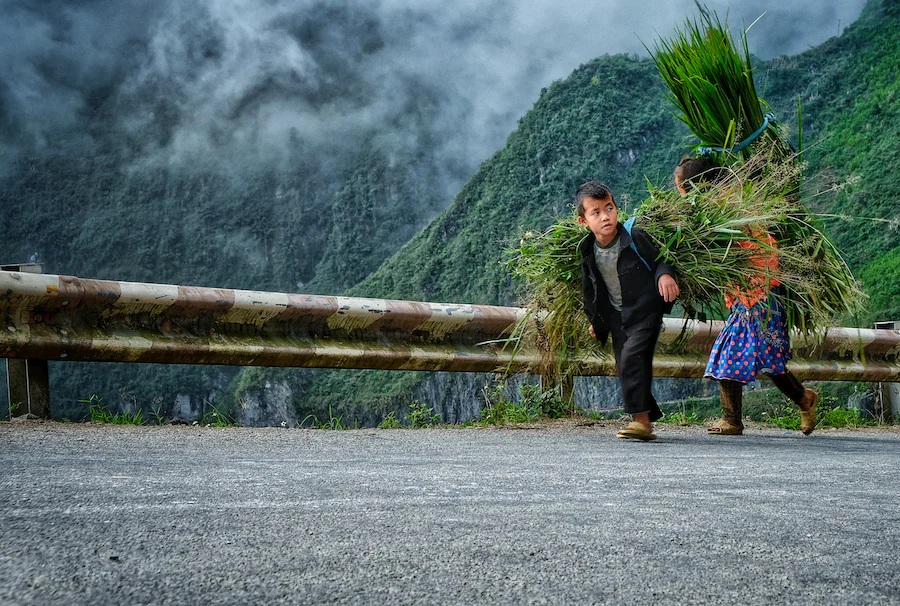The Ha Giang Loop is an epic motorbike adventure through the dramatic and diverse landscapes of Northern Vietnam. With twisting mountain roads, vertiginous passes, and vibrant ethnic cultures, the Ha Giang province offers some of the most rewarding and immersive experiences in all Southeast Asia. In this extensive guide, we’ll navigate everything you need to know to conquer the Ha Giang Loop, including the route, attractions, accommodations, safety tips, and much more.
Ha Giang Loop – The Route
The Ha Giang Loop typically starts and finishes in Ha Giang City, covering a total distance of about 350 kilometres. The conventional route goes through Quan Ba, Yen Minh, Dong Van, and Meo Vac before returning to Ha Giang City. This journey can be completed in a minimum of three days but taking 4-5 days allows for a more relaxed pace and time to explore the stunning vistas and ethnic minority cultures along the route.
Key Attractions in Ha Giang
- Quan Ba Heaven’s Gate and Fairy Bosom: As your journey begins, you will be welcomed by the Twin Mountains or Fairy Bosom and spectacular views from Heaven’s Gate.
- Lung Cu Flag Tower: Near Dong Van, a trip up to the Lung Cu FlagTower offers panoramic views of Vietnam’s northernmost point.
- Ma Pi Leng Pass: The breathtaking pass between Dong Van and MeoVac is considered one of the most beautiful mountain passes in Vietnam.
- Local Markets: The loop has several local markets like Dong Van, MeoVac, and Lung Phin markets where ethnic groups come to trade goods. This is a great way to learn about the local culture.
What you need to know about Ha Giang
Accommodations
The Ha Giang Loop has a number of accommodation options ranging from homestays to hotels. Some popular ones include Truong Xuan Resort in Ha Giang City, Bong Backpacker Hostel in Dong Van, and Hoa Cuong Hotel in Meo Vac.
Food and Drink

Northern Vietnam’s cuisine offers many unique dishes. Try “Thang Co,” a traditional Hmong stew, and don’t miss the locally brewed corn wine. Remember to stay hydrated, especially during long rides.
Bike Rental and Safety
Most travellers opt to rent motorbikes for the journey. Many rental services are available in Ha Giang City. Remember to check the bike thoroughly before starting your journey. If you’re not an experienced rider, consider hiring an Easy Rider or joining a guided tour.
Travel Insurance
Ensure you have travel insurance that covers motorbiking. Many standard policies do not cover motorbike accidents, especially if you don’t have a valid motorbike license in your home country.
Local Customs and Respect

When visiting ethnic minority communities, be respectful of their customs. Ask for permission before taking photos, dress modestly, and consider hiring a local guide to better understand their culture.
Budget Considerations
The budget for the Ha Giang Loop can vary depending on your personal travel style and preferences. On average, you can expect to spend around $20 to $30 per day. This includes bike rental, which generally costs between $10 to $15 per day. Accommodation ranges from $5 per night for basic homestays to $20 for more comfortable hotels. Food and drink costs are relatively low, with local meals costing a few dollars. However, these costs can add up over several days, and it’s always smart to have a bit of extra money set aside for any unexpected expenses. Keep in mind that many places in the rural areas of the loop may only accept cash, so plan accordingly. Additionally, remember to factor in the cost of travel insurance that covers motorbiking, which is an essential safety net while navigating this adventurous route.
Best Time to Visit Ha Giang
The best time to embark on the Ha Giang Loop adventure is during the dry season, which typically runs from October to April. During these months, the weather is generally more stable, making the journey less risky and more enjoyable. Specifically, October and November offer a particular treat, with the harvest season transforming the landscape into a vibrant sea of yellow rice terraces. However, if you wish to witness the bloom of the Tam Giac Mach Flower, a type of buckwheat, visiting between late October and early December is ideal. Remember that even during the dry season, weather in the mountains can be unpredictable, so always check local forecasts before setting off.
Handling Emergencies
In case of emergencies, it’s crucial to be prepared. Ensure you have a working phone with you and familiarize yourself with emergency numbers. For medical emergencies, the number to dial is 115. It’s also advisable to note down contact numbers of hospitals in major towns along the loop. Most importantly, ensure you have comprehensive travel insurance that covers medical evacuation, as in serious cases you will be transferred to big hospitals in Northern Vietnam. Always let someone know your travel plans and update them regularly, especially when travelling in remote areas. Consider carrying a basic first aid kit with you and familiarize yourself with the route and nearby medical facilities. Being prepared can go a long way in ensuring a safe and enjoyable journey on the Ha Giang Loop.
In conclusion, the Ha Giang Loop is more than just a motorbike adventure—it’s a journey into the heart of Vietnam’s cultural heritage and natural grandeur. Preparing properly and respecting local communities will ensure this adventure leaves you with unforgettable memories. Whether you’re traversing the Ma Pi Leng Pass, immersing in ethnic cultures at the local markets, or simply soaking in the incredible scenery, the Ha Giang Loop promises a unique and awe-inspiring experience.
Ready to embark on the adventure of a lifetime? Start your engines, respect the road, and let the captivating Ha Giang Loop leave you spellbound.
FAQ
Do I need a license to ride a motorbike in Vietnam?
Yes, technically, you do need a Vietnamese driving license or an International Driving Permit (IDP) that is endorsed for motorcycle usage in Vietnam. However, enforcement varies in different areas of Vietnam, and many rental agencies do rent out motorbikes without requiring these documents. But for safety and legality, it is best to have the appropriate license. Remember that not having a proper license could potentially invalidate your travel insurance in case of an accident.
Is the Ha Giang Loop dangerous?
While the Ha Giang Loop is undoubtedly challenging due to its winding mountain roads, steep cliffs, and varying weather conditions, the journey is generally safe as long as riders are cautious, prepared, and respect the local traffic rules. Always check the bike before leaving, wear a helmet and appropriate clothing, and don’t rush – the journey is more important than the destination.
What should I pack for the Ha Giang Loop?
While the Ha Giang Loop is undoubtedly challenging due to its winding mountain roads, steep cliffs, and varying weather conditions, the journey is generally safe as long as riders are cautious, prepared, and respect the local traffic rules. Always check the bike before leaving, wear a helmet and appropriate clothing, and don’t rush – the journey is more important than the destination.
Are there petrol stations along the route?
Yes, there are several petrol stations along the Ha Giang Loop. It’s good practice to top up your fuel whenever you have the chance. Also, many local shops sell petrol in bottles, so you’re never far from a refuelling point.
What if I’m not comfortable riding a motorbike for the Ha Giang Loop?
If you’re not confident in your motorbike riding skills, consider hiring an experienced Easy Rider as a driver. This way, you can enjoy the stunning scenery without the stress of navigating the roads yourself.
What if I have a breakdown or an accident in Ha Giang?
In case of a breakdown, there are plenty of small mechanic shops in towns along the route that can fix minor issues. In the event of an accident, immediately call your travel insurance provider and the local emergency services. Having a local SIM card can be beneficial for this reason. It’s also advisable to let someone know of your travel itinerary beforehand, so they know where you should be.

